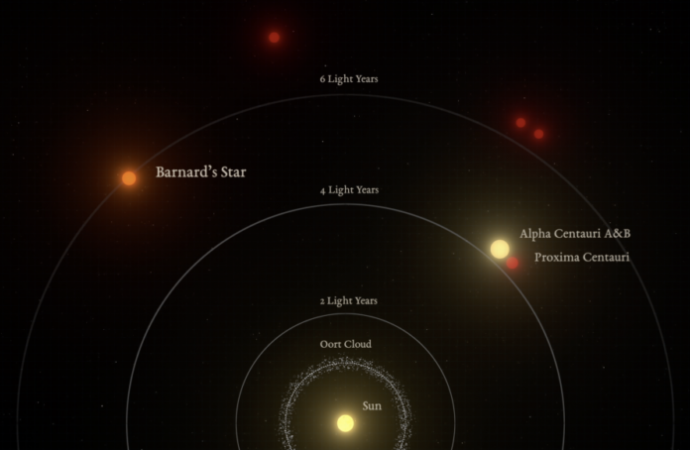A large planet appears to be orbiting out near the system’s snow line.
From the phenomenal success of the Kepler mission and a proliferation of ground-based telescopes, we now know that planets are common in our galaxy. But the methods we’ve used to detect most of them are biased toward finding large planets that orbit close to their host stars. The farther a planet is, the less its gravity pulls at the star and the less likely it is to align so that its orbit passes between that star and Earth, thus blocking out some starlight. Meanwhile, the focus has shifted to nearby stars, as astronomers have started building a catalog of targets for the next generation of telescopes.
These issues provide an intriguing backdrop for today’s announcement that one of the closest stars to Earth has a super-Earth companion. Barnard’s star is a red dwarf that is only six light years from our Solar System; only the three stars of the Centauri system are closer. But the new planet orbits far enough from Barnard’s star that it had been missed by earlier attempts. The detailed follow-up that spotted it also hints at the possibility of a separate, more distant planet, and both could help inform our models of planet formation.
A new look
Barnard’s star has been observed extensively over the years, partly because it’s so close, partly because it’s a prototypic example of a red dwarf star. These observations have included exoplanet searches, but nothing about the system stood out. But unless you observe a star regularly, there’s a chance you won’t happen to be looking at critical points in the planet’s orbit.
That seemed to be the case when a team of researchers started checking archival data for Barnard’s star images. Their analysis suggested there might be a signal of something orbiting with a 230 day period, but the data suffered from what the researchers term “very poor sampling.” So they obtained time on some telescopes to do an extensive monitoring campaign in 2016 and 2017, including simultaneous observations with more than one instrument.
The team was looking for signs that Barnard’s star was shifting back and forth due to the gravitational pull of a planet, a planet-hunting approach called the radial velocity method. This would create slight changes in the color of the light from Earth’s perspective due to the Doppler effect. If a planet produced these changes, then they would appear regularly with each of the planet’s orbits.
Analysis of Barnard’s star suggested it rotated about every 140 days (this can also cause changes, as more or less active regions of the star rotate in and out of view). But a variety of analysis methods suggested that there was an additional signal at 233 days, with a false alarm probability of only one in 1015. (There was one approach that suggested the signal wasn’t real, but that analysis is known to produce false negative results.) The strength of the signal also increased as new observations were added, reinforcing indications that it’s real.
A new planet—or two?
The largest changes in a star’s radial velocity will come when the plane of the planet’s orbit is aligned with Earth. If this were the case with the newly spotted planet, it would have a mass of 3.2 times that of Earth, placing it in the super-Earth category. If the orbit has a different orientation, then the planet will be heavier. The timing of the signal indicates that the planet orbits at about the same distance as Mercury orbits our Sun.
That location is interesting from a planetary science perspective. While Mercury is in a hot location in our Solar System, Barnard’s star is much dimmer, so the conditions at that distance are much cooler there. So cool, in fact, that it’s right at the location where some volatile chemicals, like water, would start to freeze out and form clumps of ice—scientists call that distance the snow line.
While there are different snow lines for each chemical (carbon dioxide doesn’t freeze out where water will), the presence of any solids should dramatically change the dynamics of the disks that give rise to planets. Modeling has suggested that the location of the snow line may be the most efficient location to form a planet, which might then migrate elsewhere in the exosolar system in response to its interactions with the disk.
Might that have happened at Barnard’s star? It’s standard practice during this analysis to remove all indications of a newly found planet and then re-analyze the data to see if any additional signals are present. When the researchers did that here, a second, far weaker signal at 6,600 days appeared. While not yet strong enough to rule out a false detection, the researchers figured out what it would mean anyway: a Neptune-sized planet orbiting slightly closer than Jupiter orbits in our Solar System. Even weaker signals were still present after that was removed, suggesting Barnard’s star is worth long-term monitoring.
Even if the other potential planets turn out to be busts, the one that does appear to be there would be close enough to us, and far enough from Barnard’s star, that we could image it directly using hardware that should come online within the next decade. So one way or another, Barnard’s star will likely make numerous appearances in the headlines over the next few years.
Source: ars Technica

































Leave a Comment
You must be logged in to post a comment.